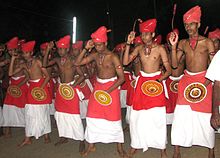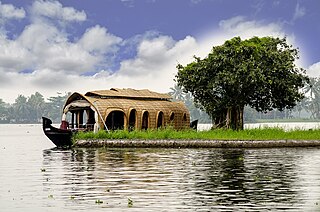
Alappuzha district, is one of the 14 districts in the Indian state of Kerala. It was formed as Alleppey district on 17 August 1957, the name of the district being changed to Alappuzha in 1990, and is the smallest district of Kerala. Alleppey town, the district headquarters, was renamed Alappuzha in 2012, even though the anglicised name is still commonly used to describe the town as well as the district.

The Kingdom of Travancore (/ˈtrævənkɔːr/), also known as the Kingdom of Thiruvithamkoor, was an Indian kingdom from c. 1729 until 1949. It was ruled by the Travancore Royal Family from Padmanabhapuram, and later Thiruvananthapuram. At its zenith, the kingdom covered most of the south of modern-day Kerala, and the southernmost part of modern-day Tamil Nadu with the Thachudaya Kaimal's enclave of Irinjalakuda Koodalmanikyam temple in the neighbouring Kingdom of Cochin. However Tangasseri area of Kollam city and Anchuthengu near Attingal in Thiruvananthapuram district, were British colonies and were part of the Malabar District until 30 June 1927, and Tirunelveli district from 1 July 1927 onwards. Travancore merged with the erstwhile princely state of Cochin to form Travancore-Cochin in 1950. The five Tamil-majority Taluks of Vilavancode, Kalkulam, Thovalai, Agastheeswaram, and Sengottai were transferred from Travancore-Cochin to Madras State in 1956. The Malayalam-speaking regions of Travancore-Cochin merged with the Malabar District and the Kasaragod taluk of the South Canara district in Madras State to form the modern Malayalam-state of Kerala on 1 November 1956, according to the States Reorganisation Act, 1956 passed by the Government of India.

Kalaripayattu is an Indian martial art that originated in modern-day Kerala, a state on the southwestern coast of India. Kalaripayattu is known for its long-standing history within Indian martial arts, and is one of the oldest surviving martial arts in India.

Sree Padmanabhadasa Sree Chithira Thirunal Balarama Varma, popularly known as Sree Chithira Thirunal, was the last ruling Maharaja of the Princely State of Travancore, in southern India until 1949 and later the Titular Maharajah of Travancore until 1991. Sree Chithira Thirunal was the eldest son of Junior Maharani of Travancore, H.H. Sree Padmanabhasevini Vanchidharmavardhini Rajarajeshwari Maharani Moolam Thirunal Sethu Parvathi Bayi, and Sri Pooram Nal Ravi Varma Koyi Thampuran of the Royal House of Kilimanoor. He was privately educated, and became the Maharajah of Travancore, at the age of 12, upon the death of his maternal great uncle, the then Maharajah of Travancore Sree Moolam Thirunal, on 7 August 1924.

Anizham Thirunal Marthanda Varma was the founding monarch of the southern Indian Kingdom of Travancore from 1729 until his death in 1758. He was succeeded by Rama Varma (1758–98).

The Malayali people are a Dravidian ethnolinguistic group originating from the present-day state of Kerala in India, occupying its southwestern Malabar coast. They are predominantly native speakers of the Malayalam language, one of the six Classical languages in India. The state of Kerala was created in 1956 through the States Reorganisation Act. Prior to that, since the 1800s existed the Kingdom of Cochin, the Kingdom of Travancore, Malabar District, and South Canara of the British India. The Malabar District was annexed by the British through the Third Mysore War (1790–92) from Tipu Sultan. Before that, the Malabar District was under various kingdoms including the Zamorins of Calicut, Kingdom of Tanur, Arakkal kingdom, Kolathunadu, Valluvanad, and Palakkad Rajas.

Kunchan Nambiar was a prominent Malayalam poet of the 18th century (1705-1770). Apart from being a prolific poet, Nambiar is also famous as the originator of the dance art form of Thullal, most of his works were written for use in Thullal performances. Social criticism wrapped in humor is the hallmark of his works. Nambiar is one of the foremost comedians in Malayalam.
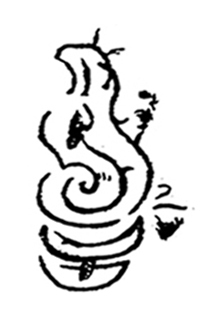
Venad was a medieval kingdom lying between the Western Ghat mountains and the Arabian Sea on the south-western tip of India with its headquarters at the port city of Kollam/Quilon. It was one of the major principalities of Kerala, along with kingdoms of Kannur (Kolathunadu), Kozhikode (Nediyiruppu), and Kochi (Perumpadappu) in medieval and early modern period.

Ārāttu is an annual ritual performed during Hindu temple festivals in Kerala, India, in which a priest bathe the idol of a deity by dipping it in a river or a temple tank. It is mainly carried out at the end of a temple festival. Ārāttu is celebrated twice annually—the spring festival and the autumn festival. A festival normally lasts 10 days.

The culture of Kerala has developed over the past millennia, influences from other parts of India and abroad. It is defined by its antiquity and the organic continuity sustained by the Malayali people. Modern Kerala society took shape owing to migrations from different parts of India and abroad throughout Classical Antiquity.
The history of Thiruvananthapuram dates back to the 18th century AD. In 1795, the city became capital of the princely state of Travancore. Several historic landmarks of the city, including the Kowdiar Palace, University of Kerala, and Napier Museum were built during this period. After independence, Thiruvananthapuram was made the capital of the state of Kerala.

The Kingdom of Thekkumkur was an independent kingdom in the southern part of Kerala in India from 1103 CE until 1750 CE. It was ruled by the Thekkumkur Royal Family. Thekkumkur lies between the Meenachil River and the Pamba River, from the Western Ghats to the Vembanad Kayal. Thekkumkur emerges as a result of administrative changes in the princely states at the end of the Chera Kulasekhara dynasty of Mahodayapuram. The literal meaning of the title is the southern regent and the attribute southern distinguished them from another kingdom known as Vadakkumkur which bordered it in the northern side. The royal household, Thekkumkur Kovilakam, were at Vennimala and Manikandapuram near Puthuppally, later it shifted to Neerazhi Palace at Puzhavathu of Changanassery and Thalilkotta at Thaliyanthanapuram (Kottayam).
Panicker was a title conferred by the king of Travancore to distinguished individuals. Kiriyathil/Illathu Nair panickers should not be confused with Kalari Panicker

The Travancore royal family was the ruling house of the Kingdom of Travancore. They gave up their ruling rights in 1949 when Travancore merged with India and their political pension privileges were abolished in 1971. The family is descended from the Ay/Venad family and the Chera dynasty.
There are numerous ceremonies and customs adopted by the Nair caste, which is prominent in the South Indian state of Kerala.

Alappat Sreedhara Menon, known as A. Sreedhara Menon, was an Indian historian from Kerala. He is best known as the State Editor (1958–68) of Kerala District Gazetteers (1961–1975). He served as registrar of the Kerala University from 1968 to 1977, before retiring in 1980.
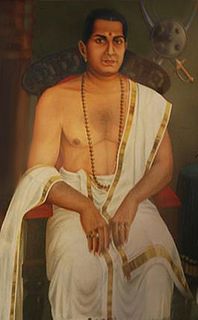
Kottayam (Cotiote) is a former vassal feudal city-state in the erstwhile province of Malabar in present-day Kerala, in the Indian subcontinent. Kottayam (Cotiote) is famed for Pazhassi Raja, one of the principal leaders of the Wayanad Insurrection. Pazhassi Raja was a member of the western branch of the Kottayam royal clan. When Hyder Ali of the Kingdom of Mysore occupied Malabar in 1773, the Raja of Kottayam found political asylum in Travancore. In 1790, the British recognized Pazhassi Raja as the head of Kottayam instead of the original Raja who had taken refuge at Travancore.
The Thachudaya Kaimals were a lineage of ruling chiefs in Travancore, now in the Indian state of Kerala. The Thachudaya Kaimal is a sacerdotal dignitary in Kerala and is considered the spiritual chief and temporal ruler of the Koodalmanikyam Temple and its estates. The line goes back into antiquity and is mentioned in the Skanda Purana. Tradition dictates that the Guruvayur temple belonging to the Zamorin of Malabar, the Koodalmanikyam temple of the Thachudaya Kaimal family of Travancore and the Sree Padmanabhaswamy Temple of the Travancore royal family are the grandest temples in Kerala in terms of size and proportion of offerings.
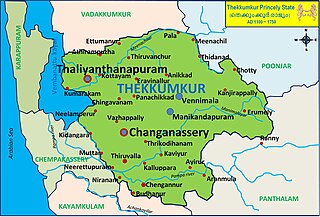
The Battle of Changanacherry was a battle between the kingdoms of Thekkumkur and Travancore in September 1749. Defeat in this decisive battle led to Thekkumkur losing its dominance and expanding the Tranvancore empire to the southern border of the river Meenachilar.
Mathoor Govindan Kutty was an Indian Kathakali artist from the state of Kerala. In a career spanning over six decades, he specialized in Kathakali Stri Vesham, the portrayal of female characters on stage. He was the recipient of the 2011 Kerala State Award for the best Kathakali artist and the 2005 Sangeet Natak Akademi Award for contributions to the Kathakali art form.
